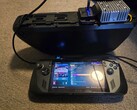Many leaks about a new Xbox handheld proved correct when Microsoft announced the device at its recent showcase. Still, some gamers were hoping for an OLED screen option, even if it came at an added cost. Instead, both the ROG Xbox Ally and ROG Xbox Ally X feature a 7-inch 1080p IPS display. Asus Senior Manager of Content Marketing Whitson Gordon appeared on a YouTube podcast to address the issue. Whitson believes that VRR is more important for a handheld gaming PC than OLED.
When developing the Xbox handheld versions of the ROG Ally, Asus tested prototypes with an OLED screen. However, the devices drew too much power and would be more expensive to manufacture. With battery life often a drawback for Windows-based handhelds, Asus didn't want to add to the problem. When considering cost, the company realizes that it will be a secondary gaming option for many buyers. Gamers are still waiting for confirmed prices on the new ROG Xbox Ally models.
Whitson is a strong proponent of VRR, which he argues every modern gaming console should offer. Variable Refresh Rate helps to keep a display's refresh rate in sync with the frame rate of a game. Otherwise, fast-paced gameplay can cause screen tearing, making the action appear choppy. An OLED screen with VRR would have increased the price of the Xbox handheld to more than most buyers would be willing to spend.
Of course, not every gamer is pleased by the decision to use an IPS screen. OLED technology produces far deeper blacks and wider viewing angles. Still, the optimized Xbox UI on the upcoming ROG Ally may come to other Windows handheld gaming PC models. By then, buyers would have more options, including the Lenovo Legion Go 2, which may ship with an 8.8-inch OLED display.





























































